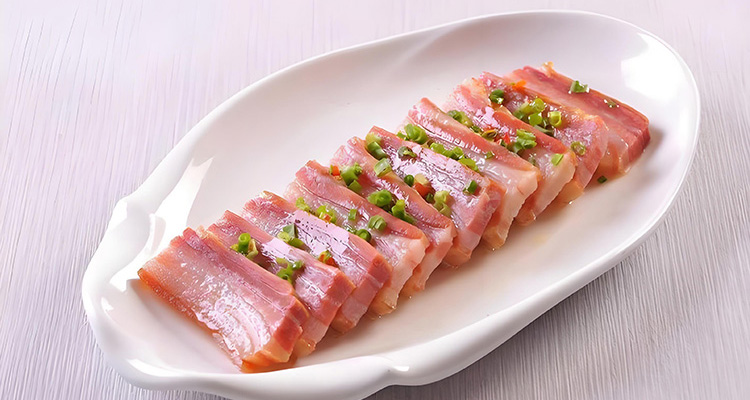Dao Ban Xiang: Discover Huizhou’s Famous Knife-Board Pork and Its 200-Year Culinary Tradition
Imagine stepping into an old Huizhou village at the foot of Huangshan. The mountain breeze carries a savory aroma—rich, salty, and faintly woody. This is Dao Ban Xiang, or Knife-Board Pork, one of Anhui’s most distinctive cured meat dishes. It reflects the wisdom of mountain life, where locals turned simple preservation into unforgettable flavor.
1. Origin and History: Preservation Born from Huizhou Life
Dao Ban Xiang emerged from Huizhou’s mountainous environment and long trade culture. In ancient times, families preserved pork to endure cold winters and lengthy merchant journeys. During the Ming and Qing dynasties, Huizhou merchants carried this cured pork as essential travel food.
The name combines “Dao Ban” (wooden cutting board) and “Xiang” (fragrance), describing both its preparation and its signature aroma. Traditionally made before Lunar New Year, it symbolized prosperity, hospitality, and readiness to welcome guests.
2. Cultural Meaning: More Than a Dish
In Huizhou culture, Dao Ban Xiang represents generosity and respect. Serving it to guests was the highest expression of hospitality. Beyond food, it’s a cultural ritual—curing pork in winter signified abundance and care for family.
The process—salting, drying, and light smoking—was both practical and symbolic, preserving meat while enriching flavor. Each piece of Dao Ban Xiang tells a story of how Huizhou people harmonized with their environment.

3. Key Ingredients: Simple but Purposeful
The authentic dish requires only two essentials: premium pork and salt. Local Huizhou black pigs are ideal for their dense meat and perfect fat balance.
Coarse sea salt helps slowly draw out moisture while retaining natural flavor. A unique feature is the camphor wood board, which infuses a delicate woody scent during steaming, absorbing excess fat and creating a clean finish.
4. Preparation: Time and Nature at Work
Authentic Dao Ban Xiang is a time-honored process spanning months:
- Curing: Large slabs of pork belly are rubbed with coarse salt and sometimes Sichuan pepper for aroma. They are tightly packed in jars for 20 days to absorb the salt.
- Drying: The meat is rinsed and air-dried in a ventilated, sunny area for several weeks until deep red.
- Fermentation: Some families allow mild fermentation for richer flavor.
- Cooking: Before serving, slices of the dried pork are steamed or simmered on a camphor wood board. The board’s fragrance seeps into the meat while soaking up oil, producing a non-greasy, deeply aromatic dish.

5. Flavor and Texture: Salty, Rich, and Balanced
Dao Ban Xiang offers a layered flavor experience. First comes the intense saltiness from curing, followed by the meat’s deep umami. The balance of lean and fat is essential: lean portions are firm and chewy, while fat turns translucent and melts in the mouth.
The camphor wood adds a subtle woody fragrance that balances the richness, leaving a clean, lingering taste.
6. How to Eat and Pairing Tips
Traditionally, thinly sliced Dao Ban Xiang is served cold as a starter or snack with alcohol. It’s also delicious over rice or noodles so the grains soak up the savory fat.
Tips:
- Best with plain rice or simple noodles to offset saltiness.
- Pair with Huizhou rice wine or light beer.
- Eat moderately—its salt content is high, so it’s best enjoyed as a side dish.

7. Traveler Tips: Where and When to Try Authentic Dao Ban Xiang
- Where to taste: The best versions are found in Huangshan City, especially Yi County and She County. Look for traditional Hui-style restaurants or farmhouse inns.
- Ordering tip: Menus often list it as “Dao Ban Xiang” or “Knife-Board Pork.” Ask for longer steaming if you prefer a milder flavor.
- Best season: Autumn and winter, when cured meat reaches peak flavor.
- Cultural note: Some heritage villages and museums offer demonstrations of the curing process—a great cultural experience.
8. Home-Style Shortcut: Recreate Huizhou’s Flavor
You can make a simplified version at home:
- Choose a good slab of pork belly.
- Rub with coarse salt and peppercorns, refrigerate 3–5 days.
- Rinse and air-dry uncovered in the fridge for 2–3 days.
- Slice and steam on a wooden or bamboo board for 20–30 minutes.
- Serve warm and enjoy the rich aroma.
9. Conclusion: A Taste of Huizhou’s Time-Honored Wisdom
Dao Ban Xiang is more than a dish—it’s a taste of history and heritage. It tells how Huizhou people embraced mountain life and transformed simple ingredients into lasting flavors. When visiting Huangshan, be sure to try a plate of this fragrant, salty delicacy and make it part of your unforgettable travel story.


